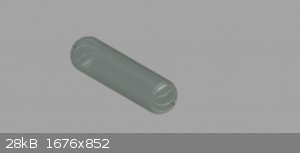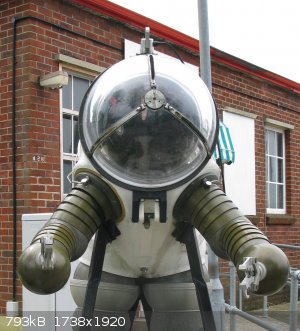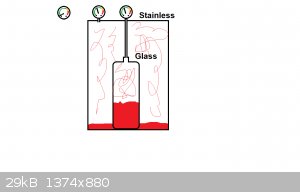low.safety.standards
Harmless

Posts: 28
Registered: 17-7-2018
Member Is Offline
|
|
Borosilicate under pressure?
Hello people,
Do anyone know of work with pressurized glassware? I'm looking for something that could withstand 20 atm at a couple hundred degrees with some 250ml
volume (working pressure would be around 10 atm). There's a guy in youtube exploding a wine bottle just under 250psi (~15 atm). Any idea on what I
could use or what thickness should I ask the glass maker to make it?

|
|
|
Sulaiman
International Hazard
    
Posts: 3558
Registered: 8-2-2015
Location: 3rd rock from the sun
Member Is Offline
|
|
Should be OK provided that you have the correct PPE

|
|
|
Deathunter88
National Hazard
   
Posts: 508
Registered: 20-2-2015
Location: Beijing, China
Member Is Offline
Mood: No Mood
|
|
Just. No. Use something else like stainless steel.
|
|
|
macckone
International Hazard
    
Posts: 2159
Registered: 1-3-2013
Location: Over a mile high
Member Is Offline
Mood: Electrical
|
|
Borosilicate is not pressure safe.
Champagne bottles will handle a lot of pressure but aren't thermal shock safe.
Stainless steel would be the way to go.
If you need to do a reaction at high pressure and stainless steel would corrode too badly, you can use PTFE coatings or a borosilicate apparatus
inside of a stainless steel autoclave of some kind.
220+ psi is pretty high pressure for a home lab and using poorly designed apparatus may result in casualties.
For reference a champagne bottle is designed with a high safety factor and for an operating pressure of 90 psi. They are designed to be safe to 12
atms and possibly more depending on the bottle (some are rated higher). They will certainly handle more pressure than a wine bottle. A good
champagne bottle should handle 220+ psi but see the above safety apparatus.
A stainless steel CO2 fire extinguisher should be the right item to hold that kind of pressure.
|
|
|
Heptylene
Hazard to Others
  
Posts: 319
Registered: 22-10-2016
Member Is Offline
Mood: No Mood
|
|
As proposed by macckone, you can place the glass reactor inside a stainless steel one. By using a liquid with the appropriate boiling point inside the
stainless steel reactor you could mitigate the pressure the glass reactor is subjected to. The glass reactor will only "feel" the pressure difference
between inside and outside.
For this to work you would need to make sure the intended reaction inside the glass reactor doesn't produce a lot of gasses, and you would have to
heat and cool the whole thing slowly, such that the pressure differential between the inside and the outside of the glass reactor is minimized.
I've seen pressure glass reactor on ebay that are stated to work up to 6 bars. I wouldn't trust those on their own, but if contained inside a
stainless steel shield they should be safe enough.
The gauge in the drawing show 3 pressure gauges: ambiant atmosphere, inside the SS reactor, and inside the glass reactor.

|
|
|
low.safety.standards
Harmless

Posts: 28
Registered: 17-7-2018
Member Is Offline
|
|
Ingeniously simple solution! Part of the problem is corrosion, most of it is that I wanted to see inside 
...but that can be achieved with a 1" polyurethane window on a CO2 fire extinguisher holding my "not pressure rated" borosilicate reaction vessel,
thanks!
Anyway, also found https://www.schott.com/d/tubing/9a0f5126-6e35-43bd-bf2a-3499... which gives an approximate pressure rating equation for tubular glass given wall
thickness and outside diameter.
|
|
|
macckone
International Hazard
    
Posts: 2159
Registered: 1-3-2013
Location: Over a mile high
Member Is Offline
Mood: Electrical
|
|
If polyurethane is suitable for a containment vessel, you may be able to use a polyurethane tube and then use end plates attached with high strength
steel. Not sure what thickness you would need for that pressure rating. Honestly I would go straight stainless with a camera inside.
If you are using a fire extinguisher you still need to get your reaction equipment inside, if you are using a test tube that should be easy. For a
500ml flask, not so much.
|
|
|
low.safety.standards
Harmless

Posts: 28
Registered: 17-7-2018
Member Is Offline
|
|
It's not, I meant it as a window for the pressurized autoclave containing the borosilicate glass.
|
|
|
nimgoldman
Hazard to Others
  
Posts: 303
Registered: 11-6-2018
Member Is Offline
|
|
Look up "hydrothermal autoclave reactor" on eBay. The lowest grade ones withstand up to 3 MPa which is almost 30 atm. There are 6 MPa and even 22 MPa
models, though much more expensive.
It basically a thick-walled stainless steel vessel with fine threads on one end and internal chamber made of PTFE or PP.
They come in variety of volumes from 10 mL to 500 mL.
Another (cheaper) option is a stainless steel pipe with threads on both ends. You can cover the threads with Teflon tape and tightly seal with caps.
[Edited on 21-9-2018 by nimgoldman]
|
|
|
NeonPulse
Hazard to Others
  
Posts: 417
Registered: 29-6-2013
Location: The other end of the internet.
Member Is Offline
Mood: Isolated from Reality! For Real this time....
|
|
Can I ask what we’re you planning to do under such pressure?
|
|
|
Metacelsus
International Hazard
    
Posts: 2531
Registered: 26-12-2012
Location: Boston, MA
Member Is Offline
Mood: Double, double, toil and trouble
|
|
I've used thick-walled borosilicate pressure vessels at 150 °C and 10 bar pressure. I'm talking about something like this: https://us.vwr.com/store/product/4831644/pressure-tubes-with...
(They can also withstand 300 °C and 5 bar, but I'd be wary of using 10 bar at that temperature.)
|
|
|
BromicAcid
International Hazard
    
Posts: 3227
Registered: 13-7-2003
Location: Wisconsin
Member Is Offline
Mood: Rock n' Roll
|
|
I've used Ace pressure tubes like these:
https://www.sigmaaldrich.com/catalog/product/aldrich/z564591
I used an oil bath to heat them. Even though they were rated for the pressure I was using, I put them behind a blast shield and attached them to the
end of a rod on a pivot so I could dunk them and lift them out of the liquid without having to get behind the shield.
|
|
|
Metacelsus
International Hazard
    
Posts: 2531
Registered: 26-12-2012
Location: Boston, MA
Member Is Offline
Mood: Double, double, toil and trouble
|
|
Yes, a blast shield is highly advisable (and something which I forgot to mention in my post above!)
I've never had one explode, but I expect if the tube broke under pressure a powerful BLEVE would result.
|
|
|
Dr.Bob
International Hazard
    
Posts: 2658
Registered: 26-1-2011
Location: USA - NC
Member Is Offline
Mood: No Mood
|
|
For 250 ml, a glass vessel is really pushing it, even for the Ace or Aldrich pressure tubes, and if you heat them, the rating goes down further.
Just use a glass lined steel pressure reactor, they can handle that with little hazard, just have to be careful when opening them to vent them slowly.
Even the best chemical microwave systems barely go up to those pressures and temps, typically only for 2-20 ml.
|
|
|